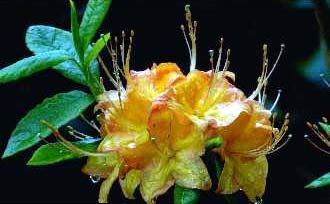Many plants are well suited for gracing around an arbor and providing a curtain of delicate blooms and privacy. Some creep, some cling, others climb; some are annuals, others are perennials.
Around the end of the 19th century, the Art Nouveau movement, with its emphasis on flowing lines, ushered in a fashion for flower-covered arbors and gazebos. Climbing vines became quite popular. On walls, trellises, espaliers, and any number of other structures, blooming vines, climbers, and other spreading plants were grown as an expression of an underlying desire to bring life and greenery to otherwise barren and gray city buildings. It is no secret that living plants decidedly improve the quality of life.
Careful Planting
Climbing plants need sufficient space in order for their roots to grow. Because with an arbor the root area is limited on one side by a wall, certain rules apply to planting alongside an arbor. The soil must be light, easily penetrable by the roots, and sufficiently deep to accommodate plants as they mature.
Sufficient Rooting Space
Annuals such as monastery bells (also known as cup-and-saucer vine) and nasturtiums will need loose soil extending to about 1 foot deep. Hardy species like clematis and Virginia creeper (American ivy) will require a soil depth of about 1 1/2 feet. The ground should be excavated to the required depth and the planting soil should be prepared. Heavy, loamy soil should be amended with the addition of sand; light soil needs compost added. All rocks, stones, building debris, and weeds must be removed. Bone meal, which is rich in phosphorus and nitrogen, should be added to the soil mixture.
Most climbing vines and plants come in containers and are not difficult to transplant. They should be planted no deeper than they were in their original containers. Firm the soil by treading on it lightly and water it thoroughly so that it will settle in around. Mulch the base of the plant with leaves, bark, or grass cuttings.
Train and Tie Plants
Climbers need to be trained from the start to grow on some kind of support. Position young and still flexible shoots in the desired direction and attach them to the support structure with string or twist ties. After a short while the plants will twine themselves around the support without further help. When tying to provide support, keep in mind that some plants naturally twine to the left and others to the right. Start them off in the directions in which they grow naturally.
Climbing roses are different; they neither twine nor adhere by themselves to a wall. The canes need to be tied in place as they grow.
TIPS:
If you cannot quite make up your mind whether you want to commit to a permanent plant variety for your arbor, try using some annuals first. After a season you will have a better feel for what you want - plants affording great privacy or ones that are purely decorative. With a year's experience behind you, whatever you decide to plant on a permanent basis for your arbor, your efforts will be much more successful and rewarding.
KEY STEPS TO PLANTING AROUND AN ARBOR
1. Select plants according to your location and their requirements
Annual species are preferable as they will take less time to establish and they will flower sooner. Plants started in containers can be planted throughout the year; bare-root plants should be planted in autumn.
2. Prepare your planting hole
In digging your planting hole, be sure it is deep enough for the plant you intend to put there. The dimensions of the hole will depend on the size the plant reaches in its maturity, but a surface area of 1 '/2 feet x 1 '/2 feet will be sufficient for most. Depending on soil quality, amend with compost, sand, or peat moss. For initial fertilizing, add bone meal or other organic supplement.
3. Planting
Set plant in at an angle toward the support structure. Tread on the soil to firm it. Secure shoots to the support structure with string or twist ties. Some vining shrubs and plants must be tied and trained according to their growth habit. Left-twining vines like scarlet runner beans must be secured to the beam in a counterclockwise direction.
4. Initial care
Cover the base of the plant with leaves, bark chips, or grass cuttings and water thoroughly. Prune roses and some other species immediately after planting. Some species with shallow root systems, like clematis, require a protective planting such as mulch around the base, which will keep the root area cool.
Climbing Hardy Plants for Sunny, Warm Locations
Annual Climbers
Actinidia (Actinidia): Easy to care for, several species
Five-leaf akebia (Akebia quinata): Easy to care for, fast-growing
Boston ivy (Parthenocissus tricuspidata): Decorative foliage and flowers
Trumpet creeper (Campsis): Magnificent flowers
Virgin's bower (Clematis): Hybrids come in many colors
Virginia creeper (Parthenocissus quinquefolia): Decorative foliage, fall color
Climbing roses (Rosa): Needs attention, many varieties
Wine grape (Vitis vinifera): Needs lots of warmth and attention
Wisteria (Wisteria): Singularly beautiful flowers
Monastery bells (Cobaea scanderis): Blue or white flowers
Hyacinth bean (Dolichos lablab): Quick growing
Glory flower (Eccremocarpos): Brilliant-colored blossoms
Morning glory (Ipomoea popurea): Massive flowers
Sweet pea (Lathyrus odoratus): Does not grow too tall
Scarlet runner bean (Phaseolus coccineus): Hardy, easy to care for
Black-eyed Susan vine (Thunbergia alata): Beautiful flowers, low-growing
Nasturtium (Tropaeolum peregrinum): Small yellow flowers
For Partial Shade
Birthwort (Aristolochia): Very thick foliage
Virgin's bower (Clematis): Wild varieties with small flowers
Hops (Humulus): Easy to care for, handsome foliage
Honeysuckle (Lonicera) : Many varieties, beautiful flowers
Jackman clematis (Clematis jackmanii): Hardy, several varieties
For Shade
Spindle tree (Euonymus): White-variegated varieties also exist
Ivy (Hedera): Easy to care for, many varieties
Climbing hydrangeas (Hydrangea anomala petiolaris): Beautiful flowers
Rubus henryi (Rubus henryi): Evergreen


